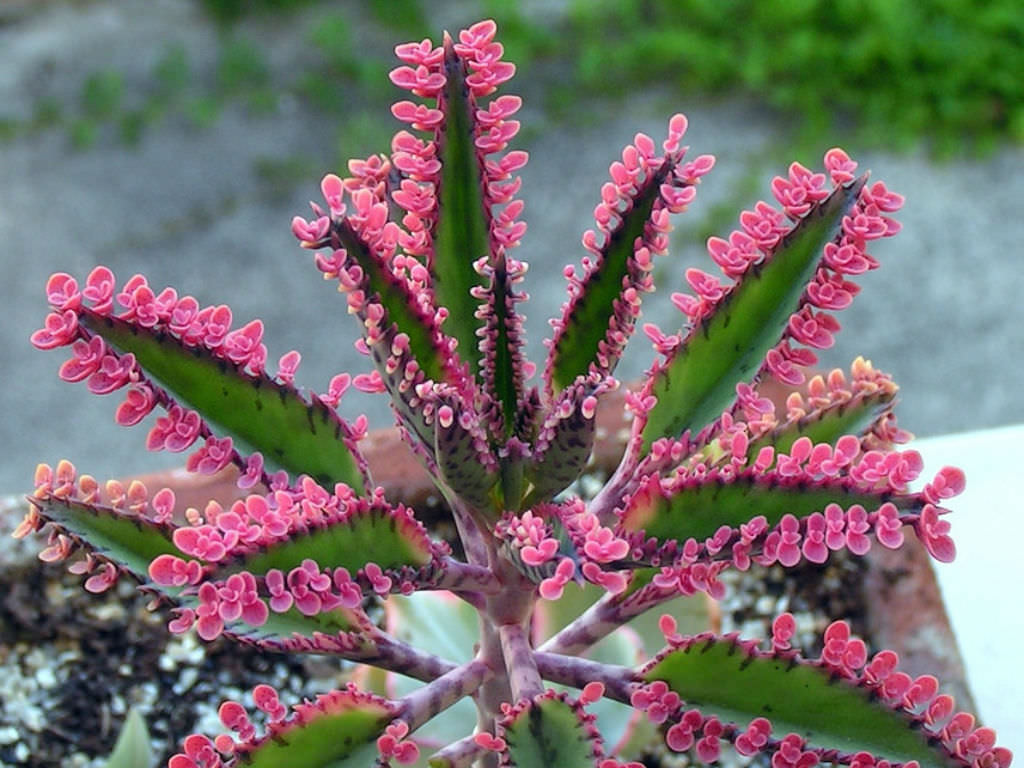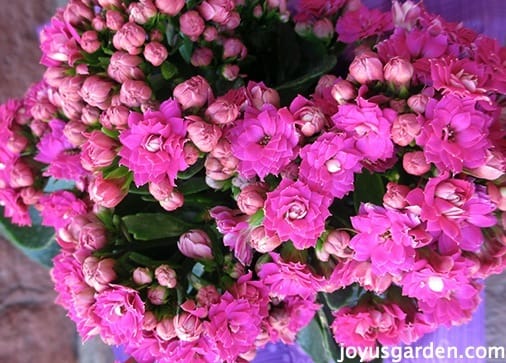Oh, how I love succulents! And a succulent with lots of long-lasting flowers is just the cat’s meow. Enter the popular Kalanchoe blossfeldianas that are most commonly sold as indoor plants. In Santa Barbara, where I used to live (USDA zone 10), mine enjoyed the great outdoors year-round. This is about Kalanchoe Care indoors and outdoors, or Kals as we call them.
These long, lasting blooming plants with colorful flowers will brighten up both your garden and home. Buy your plant with at least half of the flower buds open or partially open. This will make the flowering period last longer. They’ll gradually open after you get them home.
That’s where I get mine. I used to work in the interior design business and used them a lot in homes and offices, but I had never grown them in the garden before. I’ve discovered that Kalanchoes bloom almost all year round here with very little care. My kind of plant!.
NOTE: This post was published on 07/16/2014. I’m updating it on 06/22/2023. It’s one of the very first posts that I ever wrote. My how blogging has changed!.
I’ve since written newer posts on Kalanchoe Care as houseplants. Instead of making a lot of changes to this post, I’ll link to these more recent ones: Growing Kalanchoe FAQs, Kalanchoe Care, and Calandiva Care. They have more information and tips.
Kalanchoes are popular succulent houseplants, prized for their colorful blooms and ease of care. There are over 100 kalanchoe species, but one of the most beloved is kalanchoe blossfeldiana, which produces clusters of tiny flowers in a range of colors – including pretty pink blooms.
If you’re new to growing succulents, a kalanchoe with pink flowers is a great option. These hardy plants are easy to find simple to grow and provide long-lasting color. Read on to learn all about caring for kalanchoe succulents with pink blooms.
Kalanchoes are native to Africa and Madagascar where they thrive in warm sunny climates. They’ve become popular houseplants worldwide thanks to their drought tolerance. The name kalanchoe comes from the Chinese words “kalan chau,” meaning “that which falls and grows.” This refers to the plantlets that form along kalanchoe leaves and drop off to grow new plants.
There are over 100 kalanchoe species, but most houseplants are K. blossfeldiana. These plants grow up to 18 inches tall and produce scallop-edged leaves. Flower colors include red, orange, yellow, white, and pink. Blooms appear in winter and spring.
Beyond their flowers, kalanchoes are valued for their sculptural foliage. Many species have thick, rounded leaves with a powdery coating. These succulents store water in their leaves and stems, allowing them to survive with minimal watering. Their drought-hardy nature makes them ideal for beginners.
Caring for Kalanchoe Succulents
Kalanchoe care is straightforward, as long as you meet their basic needs:
Light: Bright, indirect light indoors. Morning sun and afternoon shade outside.
Water: Allow soil to dry out between waterings. Less water in winter.
Soil: Fast-draining cactus mix.
Temperature: 55-80°F. Bring indoors if below 55°F.
Fertilizer: Balanced houseplant fertilizer every 1-2 months during spring and summer.
Potting: Repot in fall after blooming. Use clay pots for drainage.
Proper care will keep your kalanchoe healthy for years. Watch for pests like aphids, mealybugs, and scale. Prune off damaged leaves and flowers to encourage new growth.
Now let’s look at caring specifically for kalanchoes with pink blooms.
Choosing a Kalanchoe Variety with Pink Flowers
Many kalanchoe varieties produce pink flowers. Here are some top options:
- K. blossfeldiana – This popular houseplant has clusters of small pink blooms.
- K. fedtschenkoi – Lavender-pink dangling bell flowers.
- K. luciae – Light pink blooms on “flapjack” succulents.
- K. pumila – Pale pink flowers on a low, spreading succulent.
- K. rhombopilosa – Trailing kalanchoe with bright pink blooms.
Look for kalanchoes with vibrant green, pest-free leaves and healthy stems when choosing your plant. Avoid leggy plants with yellowing leaves.
Providing the Right Care for Pink Kalanchoes
Kalanchoe care is the same regardless of flower color. Provide the following to keep your pink kalanchoe thriving:
- Sunlight: Pink kalanchoes need at least 6 hours of sun. Insufficient light causes leggy growth.
- Water: Allow soil to dry between waterings. Water less in winter. Wilting means under or overwatering.
- Temperature: Ideal range is 55-80°F. Protect from frost.
- Soil: Use cactus mix or succulent soil for drainage. Re-pot annually.
- Fertilizer: Feed monthly in spring and summer with a balanced liquid fertilizer.
- Pruning: Remove dead flowers and leaves to encourage new growth.
Adjust care based on your plant’s needs. Pay attention to leaf and bloom health to ensure proper lighting and watering.
Encouraging Pink Kalanchoes to Bloom
Getting consistent blooms from pink kalanchoe requires proper lighting and care. Here are tips:
- Provide 14 hours of daily darkness for 6 weeks in fall/winter.
- Give bright, indirect light during the day. Direct sun can inhibit blooms.
- Use a phosphorus-rich fertilizer to encourage buds.
- Keep temperatures between 60-80°F for ideal flowering.
- Prune off old blooms to promote new ones.
With the right conditions, kalanchoe can bloom all year. Be patient if your new plant isn’t blooming yet. Focus on healthy growth and the flowers will come.
Displaying Pink Kalanchoe Plants
One of the joys of growing kalanchoe is their long bloom time. You’ll want to showcase their pink flowers. Here are tips:
- Place in an east or west window where light isn’t too harsh.
- Mix colors by combining them with red, orange, or yellow kalanchoes.
- Add contrast by grouping them with green foliage plants.
- Allow trailing types to spill over shelves or hang in suspended pots.
- Cut blooms to add to floral displays and bouquets.
Kalanchoes look great alone or combined with other houseplants. Use pink blooms to brighten winter windowsills.
Troubleshooting Common Kalanchoe Problems
Even easy kalanchoes can develop issues. Watch for:
- Leggy growth – Needs more sunlight
- Wilt – Under or overwatering
- Burnt leaf tips – Too much direct sun
- Failure to bloom – Lack of darkness or phosphorus
- Root/stem rot – Overwatering
- Pests – Aphids, mealybugs, scale
Catch problems early and adjust care. Discard plants with severe infestations.
Propagating Pink Kalanchoes
You can propagate new pink kalanchoe plants from offsets, leaves, or cuttings:
- Remove an offset or take a 3-4 inch stem tip cutting.
- Allow to dry for 1-2 days until calloused.
- Dip in rooting hormone (optional).
- Plant in well-draining soil.
- Place in indirect light and wait 1-2 months for roots.
- Begin watering once rooted.
This allows you to easily multiply your plants. Give baby kalanchoes as gifts!
Common Questions About Pink Kalanchoes
Here are answers to some frequently asked questions:
How long do kalanchoes live? They can live for over 20 years with proper care.
Should kalanchoes be grown indoors or outdoors? They do best indoors but can live outside year-round in zones 10-12.
When is the best time to plant kalanchoe? Spring is ideal but you can plant them any time.
Why won’t my kalanchoe bloom? It likely needs more sun, phosphorus fertilizer, cooler temperatures, and winter darkness.
Are kalanchoes toxic to pets? Yes, kalanchoes contain toxic compounds and should be kept away from pets.
Enjoying Pink Kalanchoe Blooms
Few houseplants offer as much reward for so little work as flowering kalanchoes. Their sculptural foliage and cheery pink blooms will quickly win you over. As long as you provide this easygoing succulent with bright light, occasional watering, and well-draining soil, it will thrive indoors for years. Let kalanchoe blossfeldiana bring a pop of pink to your winter windowsill!

Kalanchoe Care In The Garden This is a Calandiva, a popular cultivar of the Flowering Kalanchoe. It has rosebud flowers & the same care requirements. So many blooms!
Bright shade. Mine get bright light and one or two hours of direct sun in the summer, no more. Too much direct sunlight will cause burn.
Once a week, thoroughly. They’re succulents, so they like to dry out between waterings.
Mine are planted in pots in half organic potting soil and half Succulent and Cactus Mix. Kalanchoes are succulents susceptible to root rot; they must be planted in well-draining soil.
I don’t use any. I plant with worm castings, then top dress with worm castings and compost every spring. Once or twice during the warm months, I’ll water in some seaweed extract.
None so far, but then they can be susceptible to mealybugs and aphids.
I trim off the spent flowers, taking the stem down to where it meets the foliage. The flowers last a long time, so I don’t have to do it too often. The plant also looks better this way.
Kalanchoe Care As Houseplants A small 4″ Kalanchoe can brighten up any spot in your home.
Now, onward to caring for them as houseplants. At the end of this post, I touch briefly on how to get them to bloom again indoors. Hint: it’s not easy.
Give yours lots of bright indirect light. As bright as possible, something close to but not in a south and/or west-facing window. Keep it away from the hot windows – touching that glass will burn it. Ouch!.
Every two weeks in the warmer months. Wait until the soil drys out before watering again. And don’t let it sit in water. Remember that they are succulents and their fleshy leaves and stems store water. If you keep them too wet, mildew can grow on them.
Too much moisture will also lead to root rot. They like to be kept on the dry side.
Tip: That piece of paper or foil may look nicer than the grow pot, but take it off when you water your plant. Do not forget that the Kalanchoe is a succulent plant. If water builds up at the bottom, it will die.
Use a potting soil mix formulated for houseplants with good drainage. A mixture of half potting soil and half Succulent and Cactus Mix would be fine. That’s what I used to plant up my new pink Kalanchoes.
Tip: Make sure the pot has drainage holes so the excess water can freely flow out.

I say if your home is comfortable to you, then your houseplants should be just fine too. They would enjoy a vacation outdoors in the warmer months (refer to outdoor care above).
Use an organic balanced liquid fertilizer like Sea Grow if you feel yours needs it. Easy does it—only two yearly applications – once in mid-spring and the other in mid-summer.
Keep an eye out for Mealybugs. They leave behind a residue that looks like specks of cotton. Aphids and Scale can also be an issue.
The foliage grows very densely. I snip away some of those leaves growing over the blooms. Those purdy little flowers will show more!.
My Kalanchoe Succulent Collection
- The Ultimate Guide to Growing Strawberries in Raised Beds - August 8, 2025
- No-Dig Garden Beds: The Easiest Way to Grow a Beautiful Garden - August 6, 2025
- How to Protect and Preserve Wood for Raised Garden Beds - August 6, 2025
